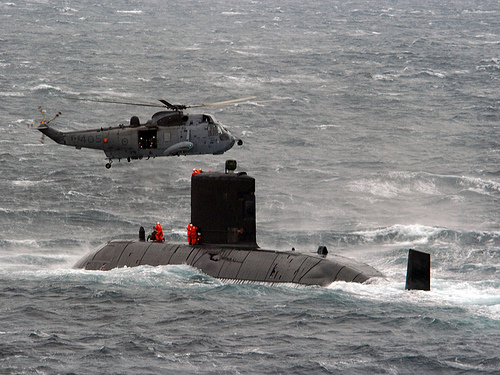By Alexei Summers (The Cascade) – Email
Print Edition: February 22, 2012
No one was really surprised when the HMCS Corner Brook (Formerly HMS Ursula) in the June of 2011, ran aground in Nootka Sound on Vancouver Island. Canada has been having problems with its four submarines since the day they were purchased.
The Royal Canadian Navy claimed it was human error that caused the submarine to hit the wall of an inlet, and the commanding officer was dismissed from his post and assigned to work ashore. The navy told reporters in a press release that the damage was not severe, and that repairs would be quick and simple. However, in recent weeks, photographs of the dry-docked Canadian sub reveal the entire nose of the Corner Brook was scooped off – a gaping hole. It is, of course, the kind of result that’s expected when a submarine hits a rock wall at a great rate of speed.
What’s really making taxpayers angry is the fact that the HMCS Corner Brook was Canada’s only operational submarine – and now it’s out of commission.
Canada has four submarines, diesel-electric relics purchased from the British at the end of the Cold War. The British decided that diesel-electric submarines were antiquated pieces of junk, wanted to make the switch over to only using nuclear subs, and consequently decided to sell the subs to Canada at the low price of 700 million pounds. Canada gladly lapped up the scraps given to it by its master, and purchased the four Victoria Class submarines, claiming it was a steal of a deal.
The idea was simple: Canada has the longest coastline in the world. Maybe it would be a good idea to have some submarines to defend it. Submarines are, after all, essential to every good modern-day naval fleet. The Royal Canadian Navy wanted to put two subs on each coast – west and east.
Good idea, right?
It didn’t quite go that way. Since their purchase from Canada’s friends across the pond, the Canadian Royal Navy has had nothing but problems with the Victoria Class submarines.
The HMCS Victoria, for example, was first commissioned in 2000. It’s been at sea only 115 days in between the years 2000 and 2010. In 2004, supposedly, the submarine’s electrical work was ruined during a refit program. It is apparently out of dry-dock now, running sea-trials. If all goes well, it will be put back into operation in 2012 or 2013. If not, it’s back to dry-dock for at least another two years of refitting.
The HMCS Windsor also had a two-year refit program that it was to undergo in 2007. Two years became three, three became four, and so on and so on. Turned out the ship was rusting. It’s not exactly a good idea to be diving down 300 metres – AKA “crush depth” – in a rusty sub, for obvious reasons.
And the HMCS Chicoutomi didn’t even make it to Canada before experiencing a fire after leaking in the wrong place. On the way from the United Kingdom to Canada, the sub was forced to radio for help off the coast of Ireland. It was towed the rest of the way to Canada, and has since been dry-docked in Halifax, with no word on how long it will be until it’s operational.
After so many problems, it’s unsurprising there have been allegations that the British Royal Navy did not store these submarines properly in the years preceding the sale and transportation to the Royal Canadian Navy. It is widely believed that the British Royal Navy housed the subs in poor conditions, allowing them to rust and otherwise deteriorate over time.
Refits to submarines take years, and a lot of taxpayer money. When a nation has a coast as large as Canada does, it needs to defend its waters. It’s infuriating that the Royal Canadian Navy is still attempting to salvage these submarines after so many ongoing problems. Many people are of the mind that perhaps it’s simply time to scuttle the four submarines, cut our losses, and never take Britain’s sloppy seconds again – especially when it comes to equipment as expensive as submarines. From the way things look, the Royal Canadian Naval Submarine Program might simply be dead in the water.


